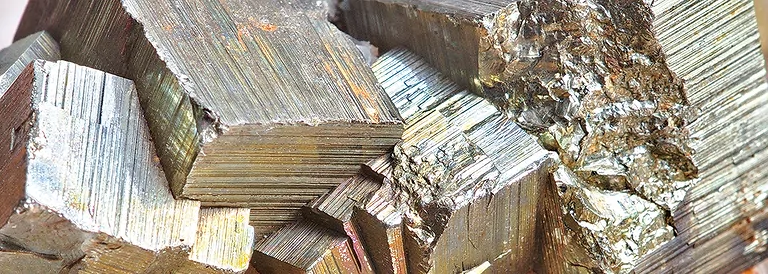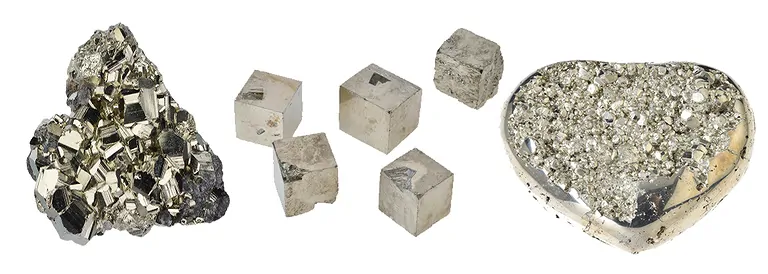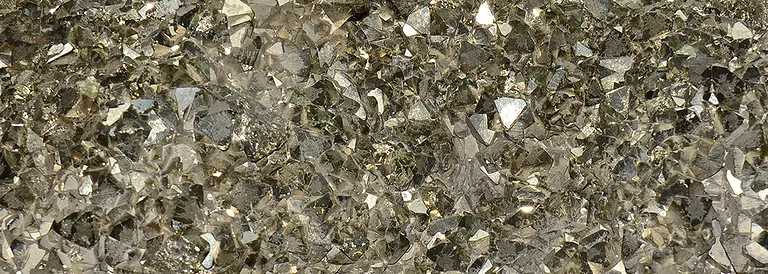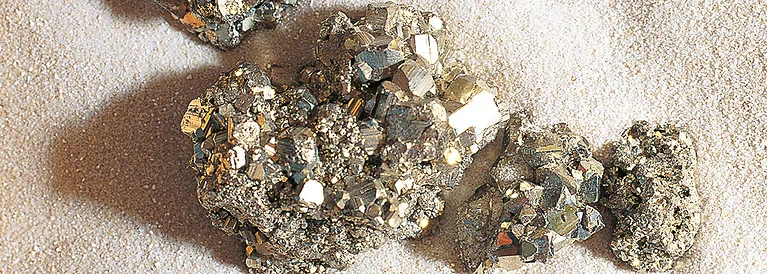
Pyrite - Bearing and meaning of the mineral
Origin of the name Pyrite and synonyms
The name Pyrite is derived from the Greek word "pyr" for "fire". For the early people Pyrite was very important, because with a hard flint small pieces of the Pyrite could be knocked off, which then ignited and burned - this is how the vital fire was lit in the past, long before there were matches and lighters. Pyrite is a iron sulfide, meaning its main constituents are iron and sulphur - sometimes you can even smell the somewhat musty odor of the sulphur! Other synonyms include sulphur/iron/yellow iron/green/carbon/stair/vitriol/cellular gravel, sideropyrite, cockscomb, inca stone, cold chedane, gravel ball, kyßgilbe, poliopyrite, sulfur iron, stragold, telaspyrite, and xanthopyrite. Folk terms related to stone healing are liver iron ore, liver gravel, and liver punch. The term "Pyrite" in the plural was often used incorrectly or collectively in the past for Marcasite, Chalcopyrite, Pyrrhotine and other yellow to brass colored minerals, thus considered as one group. With the today's knowledge this is this is no longer tenable. Mineralogically very similar to Pyrite is Marcasite, but it can be distinguished from Pyrite only in hardness and in mineralogical-gemmological way. Apache gold is mineralogically a pyrite-chalcedony mixture.
Its metallic luster and golden color also earned the Pyrite the nickname fool's gold, which derives from the word "heretic". This term appears already in manuscripts from the 12th century and is there in the descriptions clearly from real gold. Another term is fool's gold ("fool's gold"), because Pyrite has fooled many a gold miner who was happy to have stumbled upon a large lump of gold. Curiously enough Pyrite can contain tiny particles of gold in addition to silver - but these amounts are too small to be commercially exploited. Because of its fascinating luster, pyrite is very popular, especially with children.

Mineralogical profile of Pyrite
Chemical formula, mineral class: FeS2, sulfide, pyrite Marcasite family
Origination:Current: hydrothermal in veins, sedimentary in large gravel deposits of marine origin or as fine impregnation in marls, limestones, leats, also metamorphically imprinted and contact metasomatic
Color, luster: brass, gold, greenish or grayish yellow; vivid metallic luster, on the surface sometimes tarnish colors.
Crystal system: cubic
Mohs hardness: 6 to 6.5
Cleavability: imperfect splitting, brittle, conchoidal fracture
Localities, main supplying countries: Spain (especially beautiful, cubic crystals from a clay marl), Ore Mountains, Colorado/USA, Murgul (Turkey), Peru, important carrier mineral in the gold deposits of Transvaal, South Africa
Appearance: widespread in good crystals, beautiful cubes, octahedra, pentagondodecahedron, pyritohedron, pyrite sun, etc., often in association with other ore minerals such as Marcasite, Pyrrhotine, Galenite, Sphalerite, Arsenopyrite, Chalcopyrite, many other sulfides and sulfosalts, as well as Hematite, Fluorite, Barite, Quartz and Calcite.
Rough stones, tumbled stones and more Pyrite at wholesale webshop
Use: Important ore for sulfur extraction and sulfuric acid production, also a popular collector's item due to its variety of forms.
The astrology knows Pyrite as a mineral that brings to light the hidden depths of the Scorpio-born.
Gemstone healing also uses Pyrite for self-knowledge and awareness of their own shadow sides. The vernacular also calls Pyrite the "health stone", because according to ancient myths, the mineral is used to clarify causes and unclear Signs to clarify and accelerate positive processes. Most of our merchandise of Pyrite comes from Peru.

Formation and occurrence of Pyrite
Genetically, Pyrite is a mineral that can form under almost all researched conditions of formation of rocks, i.e. primary, secondary and tertiary. Primarily, it is found in all phases during the cooling of acidic melts, i.e., in magmatites, pegmatites, pneumatolytic and hydrothermal. Exemplary occurrences are: Germany, Canada, USA, Norway and Spain. In the secondary, sedimentary formation by marine decomposition processes, the decomposition of organic Sulphur is released during the decomposition of organic material in the mud of the seabed, which combines with iron or iron compounds to Pyrite under exclusion of air. Due to the aggregate crystallization (concentration) of finely distributed iron and sulfur contents during compression of the sediment by the load over it (diagenesis) also larger crystals can develop, e.g. the beautiful and well-known cubes from Navajún in Spain. Here the property of the Pyrite is of advantage, that the mineral displaces almost all in sediments occurring rock-forming minerals in sediments, in order to create space for itself. As place of formation thus also hollow structures of dead animals occur preferentially, which results in beautiful pyritized fossils. The as "gold snails" called ammonites of the Jurassic of the Franconian Alb are famous for this. Worth mentioning sites are also the Holzmaden slate from the Black Jurassic (near Stuttgart) and the Hunsrück, where mostly, however, only small pyritic concretions are found. So far only in coal shales and only by a secondary genesis were the popular Pyrite suns discovered.
In Italy, Sweden, and Cyprus, pyrite deposits are found from Tertiary genesis, when many small crystals collect into larger ones during metamorphism, or when hot magma penetrates a rock through direct contact or vapor substances are dissolved out of the surrounding rock and then form new Pyrite minerals with them.
Rough stones, tumbled stones and more Pyrite at wholesale webshop

Appearance of Pyrite
The appearance can vary greatly. In addition to cubes and other crystal forms modified from it, it is found as a specimen, the formation of which can be granular, coarse, stout, dense, crusty, bulbous, kidney-shaped or stem-shaped. Peru is known by very beautifully crystallized collector's pieces. Pyrite suns are disc-shaped radial radiate aggregates with a typical disc shape and mostly originate from the USA. Very often Pyrite is also simply diffusely distributed in the sediment. The mineral also often contains heavy metals such as Manganese, Cobalt, Nickel, Copper, Zinc, Lead etc. Important in the formation of the mineral is the encounter of iron and Sulphur under oxygen exclusion. After the compression of the mud, the pyrite crystals remain enclosed airtight in the rock. However, when pyrite from the parent rock rises to the surface, the iron oxidizes and weathers to iron oxide hydrate (limonite or brown iron ore); the sulfide is converted.
Pyrite is by far the most common sulfide mineral, which is due to its stability. So far, more than 30,000 localities could be proven worldwide, also on the moon. Even with the middle-oceanic ridges it is to be found. In the Urals up to 35 kg heavy and up to 22 cm large crystals, in Greece imposing cubes up to 50 cm edge length were found. Twinning is not uncommon, which can be easily recognized by the characteristic parallel striation of the faces ("interpenetration twins"). Absolutely worth seeing is also the "Iron Cross", crystal twins of two intergrown pentagon-dodecahedrons - found in the surroundings of Vlotho and in the Exter valley in East Westphalia.
From different epochs of the Stone Age sulfur gravel nodules with processing traces were discovered. In ancient times, Pyrite was in Greece a remedy against the "putrefaction of the blood" as well as a healing powder until the late Middle Ages in Europe and India. Foliated Pyrite was used as a mirror in South America of the pre-Incaic period. Mosaics decorated with Pyrite are known from Spain from the 8th century BC. In mythology it was processed as magical stone to amulets, because "the fire in him dwells".
Rough stones, tumbled stones and more Pyrite at wholesale webshop